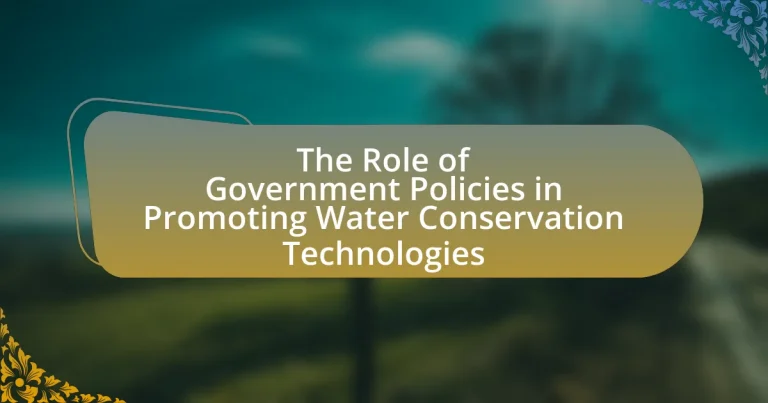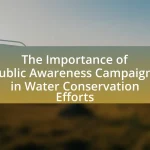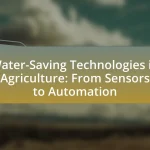The article examines the critical role of government policies in promoting water conservation technologies. It outlines how these policies establish regulatory frameworks, provide financial incentives, and raise public awareness to encourage efficient water use practices. Key components discussed include the impact of regulations, types of financial incentives, and the challenges communities face in adopting water-saving technologies. The article also highlights successful case studies and best practices for future policy development, emphasizing the importance of stakeholder engagement and evidence-based decision-making in enhancing water conservation efforts.
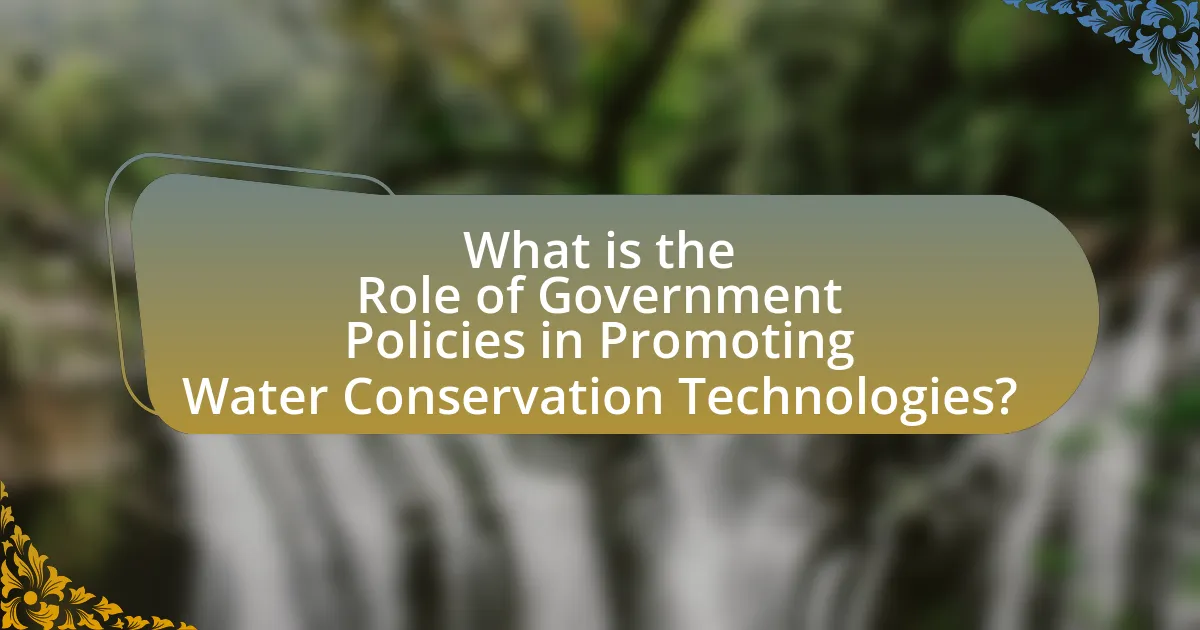
What is the Role of Government Policies in Promoting Water Conservation Technologies?
Government policies play a crucial role in promoting water conservation technologies by providing regulatory frameworks, financial incentives, and public awareness campaigns. These policies can mandate the adoption of efficient water use practices, such as requiring the installation of water-saving devices in new constructions, which has been shown to significantly reduce water consumption. For instance, California’s water conservation regulations have led to a 20% reduction in urban water use since 2013, demonstrating the effectiveness of such policies. Additionally, government subsidies for water-efficient appliances encourage consumers to invest in technologies that conserve water, further enhancing overall water management efforts.
How do government policies influence water conservation efforts?
Government policies significantly influence water conservation efforts by establishing regulations, providing funding, and promoting public awareness. For instance, policies such as the Clean Water Act in the United States set standards for water quality and encourage the implementation of conservation practices. Additionally, government incentives, like tax credits for water-efficient appliances, motivate individuals and businesses to adopt water-saving technologies. Research indicates that regions with strong water conservation policies, such as California’s water use efficiency regulations, have seen a measurable reduction in water consumption, demonstrating the effectiveness of these governmental interventions.
What types of policies are implemented to promote water conservation technologies?
Governments implement various policies to promote water conservation technologies, including financial incentives, regulatory measures, and educational programs. Financial incentives, such as grants, tax credits, and subsidies, encourage individuals and businesses to invest in water-saving technologies. Regulatory measures, like water use restrictions and efficiency standards, mandate the adoption of specific technologies to reduce water consumption. Educational programs raise awareness about the importance of water conservation and provide information on available technologies. These policies collectively aim to enhance water efficiency and sustainability in various sectors.
How do these policies vary across different regions?
Government policies promoting water conservation technologies vary significantly across different regions due to factors such as climate, economic conditions, and regulatory frameworks. For instance, arid regions like California implement strict water usage regulations and provide substantial financial incentives for adopting water-saving technologies, while regions with abundant water resources may focus less on stringent policies and more on educational campaigns. Additionally, countries in Europe, such as Germany, have comprehensive policies that integrate water conservation into broader environmental strategies, contrasting with developing regions where policies may be less formalized and more focused on immediate access to water rather than conservation. These variations reflect the unique challenges and priorities of each region, influencing the effectiveness and implementation of water conservation initiatives.
Why is government intervention necessary for water conservation?
Government intervention is necessary for water conservation to ensure sustainable management of water resources and to address market failures. Water is a finite resource, and without regulation, over-extraction and pollution can occur, leading to scarcity and environmental degradation. For instance, the United Nations reports that 2 billion people live in countries experiencing high water stress, highlighting the urgent need for policies that promote efficient water use and protect water quality. Additionally, government policies can incentivize the adoption of water conservation technologies, such as drip irrigation and rainwater harvesting, which are essential for reducing water waste and enhancing agricultural productivity.
What challenges do communities face in implementing water conservation technologies?
Communities face several challenges in implementing water conservation technologies, primarily including financial constraints, lack of awareness, and insufficient infrastructure. Financial constraints often limit the ability of communities to invest in advanced technologies, as initial costs can be high. A study by the American Water Works Association found that nearly 70% of water utilities reported budget limitations as a significant barrier to adopting new conservation technologies. Additionally, a lack of awareness and education about the benefits and operation of these technologies can hinder community engagement and participation. Research from the Water Research Foundation indicates that communities with educational programs see a 30% higher adoption rate of water-saving technologies. Lastly, insufficient infrastructure can impede the integration of new technologies, as outdated systems may not support modern conservation methods. These challenges collectively impact the effectiveness of water conservation efforts within communities.
How can government policies address these challenges?
Government policies can address challenges in promoting water conservation technologies by implementing regulations, providing financial incentives, and facilitating research and development. Regulations can mandate water efficiency standards for appliances and irrigation systems, ensuring that new technologies meet specific conservation criteria. Financial incentives, such as tax credits or grants, can encourage businesses and homeowners to adopt water-saving technologies, as evidenced by California’s rebate programs that have successfully increased the adoption of efficient fixtures. Additionally, government support for research and development can lead to innovative solutions, as seen in initiatives like the U.S. Department of Agriculture’s funding for water conservation projects, which has resulted in advancements in irrigation technology.
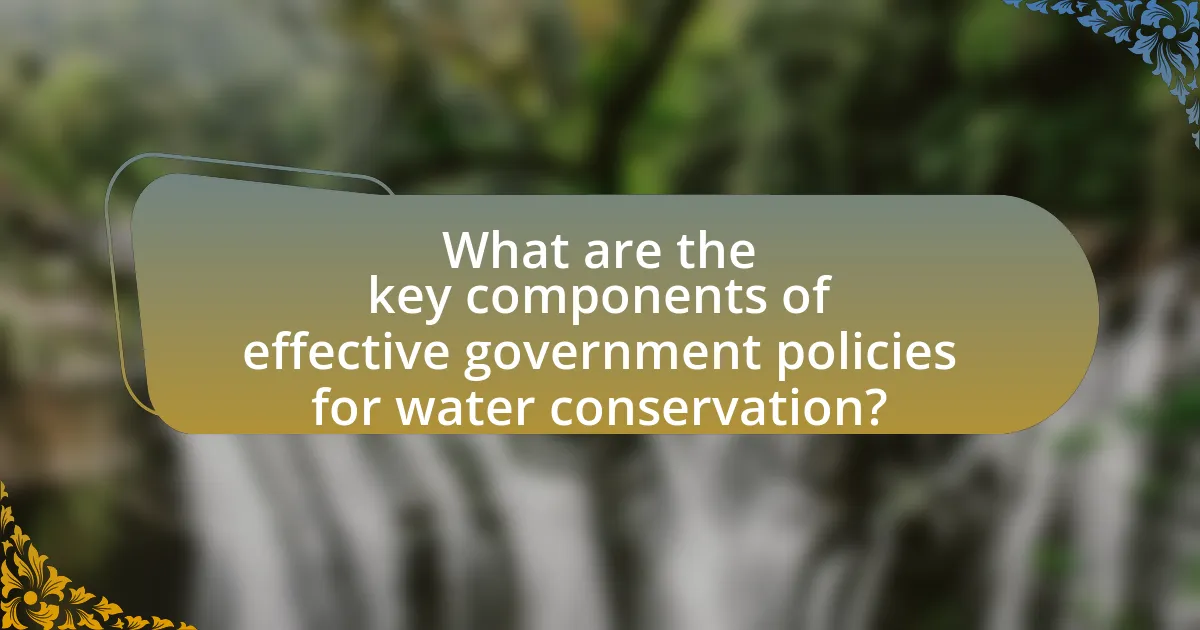
What are the key components of effective government policies for water conservation?
Effective government policies for water conservation include regulatory frameworks, financial incentives, public education, and technological support. Regulatory frameworks establish legal standards for water usage and conservation practices, ensuring compliance and accountability among users. Financial incentives, such as subsidies or tax breaks for water-saving technologies, encourage both individuals and businesses to adopt conservation measures. Public education campaigns raise awareness about the importance of water conservation and promote responsible usage behaviors. Lastly, technological support involves funding and facilitating research and development of innovative water-saving technologies, which can lead to more efficient water management practices. These components collectively enhance the effectiveness of government policies in promoting sustainable water use.
How do financial incentives impact the adoption of water conservation technologies?
Financial incentives significantly enhance the adoption of water conservation technologies by reducing the initial cost barriers for consumers and businesses. For instance, subsidies, tax credits, and grants can lower the financial burden associated with purchasing and installing water-saving devices, making them more accessible. A study by the American Water Works Association found that regions offering financial incentives saw a 30% increase in the adoption of water-efficient technologies compared to those without such programs. This correlation demonstrates that financial incentives effectively motivate stakeholders to invest in water conservation solutions, ultimately leading to improved water management and sustainability.
What types of financial incentives are most effective?
Direct cash grants and tax credits are the most effective types of financial incentives for promoting water conservation technologies. These incentives provide immediate financial relief and encourage investment in sustainable practices. Research indicates that programs offering direct cash grants can lead to a 30% increase in the adoption of water-saving technologies among households and businesses, as evidenced by a study conducted by the Environmental Protection Agency in 2021. Additionally, tax credits can reduce the upfront costs of purchasing water-efficient appliances, further motivating consumers to make environmentally friendly choices.
How do these incentives affect different stakeholders?
Incentives provided by government policies for water conservation technologies significantly impact various stakeholders, including consumers, businesses, and environmental organizations. Consumers benefit from reduced water bills and increased access to efficient technologies, which can lead to long-term savings and improved water management. Businesses, particularly those in the water technology sector, experience growth opportunities through increased demand for innovative solutions, fostering job creation and economic development. Environmental organizations gain from enhanced conservation efforts, as these incentives promote sustainable practices that protect water resources and ecosystems. Evidence from studies indicates that regions implementing such incentives have seen measurable reductions in water usage, demonstrating the effectiveness of these policies in influencing stakeholder behavior and promoting conservation.
What role does regulation play in promoting water conservation technologies?
Regulation plays a crucial role in promoting water conservation technologies by establishing standards and incentives that encourage their adoption. Governments implement regulations that mandate water efficiency measures, such as requiring low-flow fixtures in new buildings, which directly drives the market for water-saving technologies. For instance, the U.S. Energy Policy Act of 1992 set national efficiency standards for water fixtures, leading to significant reductions in water usage. Additionally, regulations can provide financial incentives, such as tax credits or rebates for consumers and businesses that invest in water-efficient technologies, further accelerating their implementation. These regulatory frameworks not only create a structured environment for innovation but also ensure that water conservation technologies are accessible and widely adopted, ultimately contributing to sustainable water management practices.
What specific regulations are commonly enacted?
Commonly enacted regulations related to water conservation technologies include mandatory water efficiency standards for appliances, restrictions on water usage during drought conditions, and incentives for the installation of water-saving devices. For instance, the Energy Policy Act of 1992 established national efficiency standards for water fixtures, which has led to significant reductions in water consumption. Additionally, many states implement tiered water pricing structures to encourage conservation, where higher usage results in increased rates, effectively promoting the adoption of water-efficient technologies. These regulations are designed to mitigate water scarcity and promote sustainable water management practices.
How do these regulations ensure compliance and effectiveness?
Regulations ensure compliance and effectiveness by establishing clear standards and penalties for non-compliance. These regulations mandate specific practices and technologies that must be adopted by water users, thereby creating a framework for accountability. For instance, the implementation of water usage limits and the requirement for water-efficient technologies compel organizations to adhere to conservation measures. Additionally, regular monitoring and reporting requirements enable authorities to assess compliance levels and enforce penalties, which further incentivizes adherence to the regulations. Studies have shown that regions with stringent water conservation regulations experience significant reductions in water usage, demonstrating the effectiveness of such policies in promoting sustainable practices.
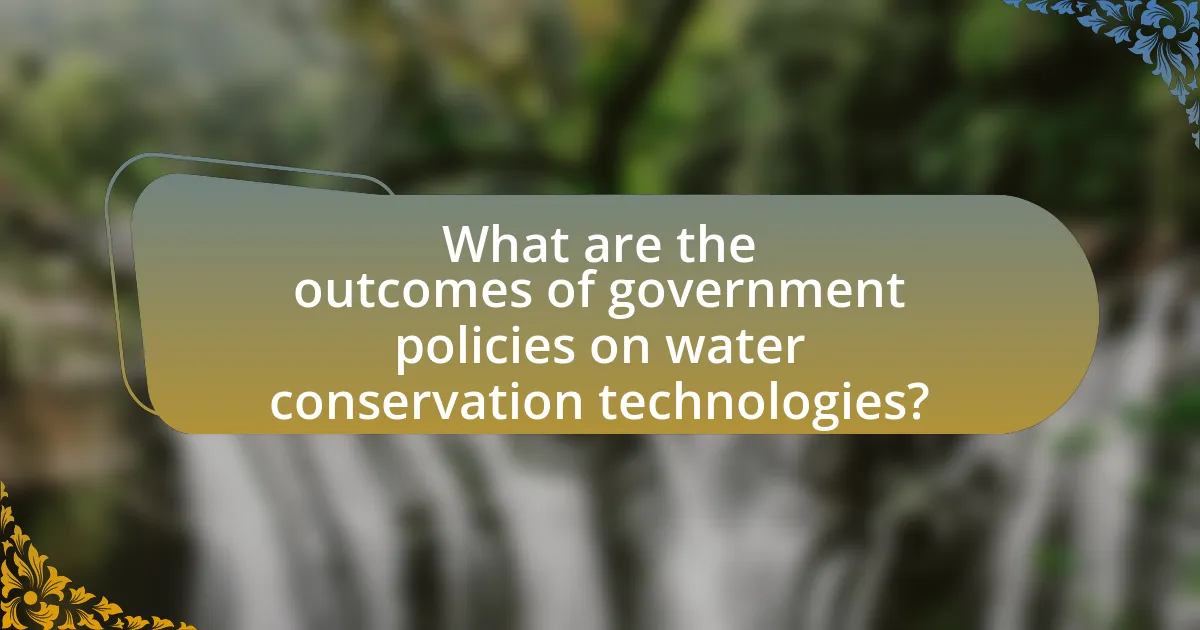
What are the outcomes of government policies on water conservation technologies?
Government policies on water conservation technologies lead to increased adoption and implementation of efficient water-saving practices. These policies often include financial incentives, such as subsidies or tax breaks, which encourage businesses and households to invest in advanced irrigation systems, rainwater harvesting, and wastewater recycling technologies. For instance, the U.S. Environmental Protection Agency’s WaterSense program has resulted in significant water savings, with over 3.4 trillion gallons of water saved since its inception in 2006, demonstrating the effectiveness of policy-driven initiatives in promoting water conservation technologies.
How do these policies affect water usage and conservation rates?
Government policies significantly reduce water usage and enhance conservation rates by implementing regulations and incentives that promote efficient water management practices. For instance, policies such as tiered water pricing encourage consumers to use less water by increasing costs for higher usage levels, leading to a reported reduction in residential water consumption by up to 20% in some regions. Additionally, government subsidies for water-saving technologies, such as low-flow fixtures and irrigation systems, have been shown to increase adoption rates, resulting in measurable decreases in water waste. Studies indicate that areas with strong policy frameworks experience higher conservation rates, with some states reporting up to 30% savings in water usage due to effective policy implementation.
What metrics are used to measure the success of these policies?
Metrics used to measure the success of government policies in promoting water conservation technologies include water savings, cost-effectiveness, adoption rates, and environmental impact assessments. Water savings quantify the reduction in water usage resulting from implemented policies, while cost-effectiveness evaluates the economic benefits relative to the costs incurred. Adoption rates indicate the percentage of targeted users who implement the technologies, reflecting the policies’ reach and acceptance. Environmental impact assessments analyze the broader ecological benefits, such as improved water quality and ecosystem health, providing a comprehensive view of the policies’ effectiveness.
How do successful policies influence public behavior towards water conservation?
Successful policies significantly influence public behavior towards water conservation by establishing clear guidelines, incentives, and educational initiatives that promote sustainable practices. For instance, policies such as tiered water pricing encourage consumers to reduce usage by charging higher rates for excessive consumption, which has been shown to decrease water use by up to 30% in some regions. Additionally, government-funded programs that provide rebates for water-efficient appliances and landscaping can lead to increased adoption of conservation technologies, as evidenced by a study from the American Water Works Association, which found that such incentives resulted in a 20% increase in the installation of water-saving devices. These approaches not only create a financial motivation for individuals to conserve water but also raise awareness about the importance of sustainable water management, ultimately leading to a cultural shift towards more responsible water use.
What lessons can be learned from successful government initiatives?
Successful government initiatives in promoting water conservation technologies demonstrate the importance of collaboration, clear communication, and evidence-based policy-making. These initiatives often involve partnerships between government agencies, private sectors, and local communities, which enhance resource sharing and innovation. For instance, California’s water conservation programs have effectively reduced water usage by 25% during drought periods through public awareness campaigns and financial incentives for water-saving technologies. This success illustrates that targeted funding and education can lead to significant behavioral changes among citizens, ultimately resulting in sustainable water management practices.
What case studies exemplify effective government policies in water conservation?
Case studies that exemplify effective government policies in water conservation include the California State Water Resources Control Board’s initiatives and Singapore’s Integrated Drainage Management Plan. California’s policies, particularly during the severe droughts, implemented mandatory water use reductions and incentivized water-efficient technologies, resulting in a 25% reduction in urban water use from 2013 to 2016. Singapore’s approach, which includes rainwater harvesting and recycling wastewater through its NEWater program, has led to a sustainable water supply that meets 40% of the nation’s needs. These examples demonstrate how targeted government policies can significantly enhance water conservation efforts.
How can these lessons be applied to future policy development?
Lessons from past government policies on water conservation can be applied to future policy development by emphasizing evidence-based strategies that effectively promote sustainable practices. For instance, successful initiatives such as California’s water conservation regulations, which resulted in a 25% reduction in urban water use during the drought from 2014 to 2017, demonstrate the effectiveness of regulatory frameworks combined with public education. Future policies should incorporate similar approaches, utilizing data analytics to identify areas of high water usage and targeting interventions accordingly. Additionally, collaboration with stakeholders, including local communities and technology providers, can enhance the adoption of innovative water conservation technologies, as seen in programs that incentivize the installation of efficient irrigation systems. By integrating these lessons, future policies can be more adaptive, responsive, and impactful in promoting water conservation.
What practical steps can governments take to enhance water conservation technologies?
Governments can enhance water conservation technologies by implementing financial incentives for research and development in this sector. For instance, providing grants or tax credits to companies that innovate water-saving technologies encourages investment and advancement. Additionally, governments can establish regulations that mandate the use of efficient water technologies in new construction projects, which has been shown to significantly reduce water consumption. A study by the American Society of Civil Engineers indicates that implementing such regulations can lead to a 20-30% reduction in water usage in urban areas. Furthermore, governments can invest in public awareness campaigns to educate citizens on the benefits of water conservation technologies, which can increase adoption rates. By combining financial incentives, regulatory measures, and educational initiatives, governments can effectively promote the development and use of water conservation technologies.
What best practices should be considered in policy formulation?
Best practices in policy formulation include stakeholder engagement, evidence-based decision-making, and clear objectives. Stakeholder engagement ensures that diverse perspectives are considered, which can lead to more effective and accepted policies. Evidence-based decision-making relies on data and research to inform policy choices, enhancing the likelihood of successful outcomes. Clear objectives provide a focused direction for policy initiatives, making it easier to measure success and adjust strategies as needed. These practices are supported by studies indicating that inclusive and data-driven approaches lead to more sustainable and effective policy outcomes in areas such as water conservation.
How can governments engage communities in water conservation efforts?
Governments can engage communities in water conservation efforts by implementing educational programs that raise awareness about water scarcity and conservation techniques. For instance, local workshops and school programs can teach residents about efficient water use, which has been shown to reduce water consumption significantly. According to the U.S. Environmental Protection Agency, communities that participate in educational outreach programs can achieve water savings of up to 20%. Additionally, governments can incentivize participation through rebates for water-saving appliances and technologies, further encouraging community involvement in conservation initiatives.
